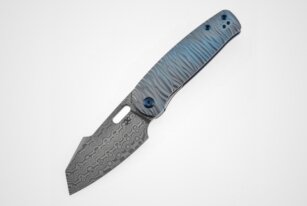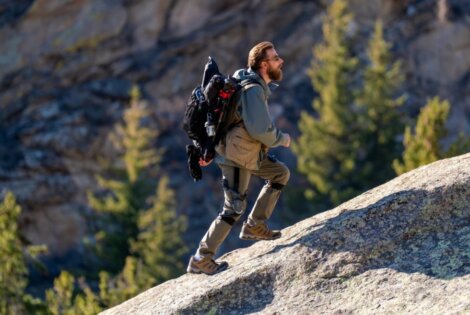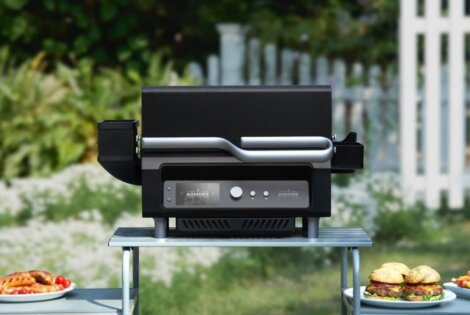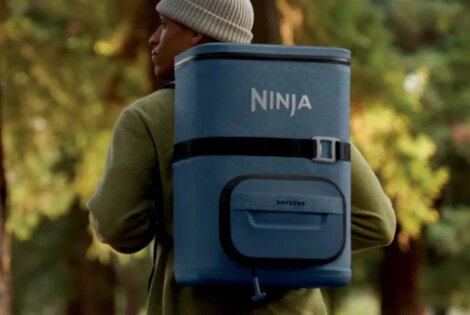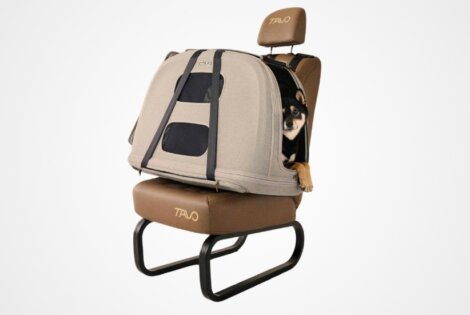Descended from wolves and domesticated to become man’s best friend, dogs still retain the predatory instincts and razor-sharp reflexes that makes them supreme hunters. Some dogs are magnificent at hunting, while others get confused if you hide their favorite toy under a blanket.
Not all breeds are blessed with the innate ability to track and hunt with pinpoint precision. Although most dogs have an instinct to chase and hunt to some degree, there are some breeds which are built for the chase – and some which are definitely not.
We don’t want to pick on any single breed here, but going on a game bird hunt with a pug or chihuahua might mean you need to stop at a MacDonald’s on the way home for dinner instead.
So which dog breeds ARE really the best for hunting: is it the bigger, the better? Not necessarily. Without further ado, let’s take a look at which breeds are the mutt’s nuts when it comes to hunting.
The Best Hunting Breeds
Contents
- The Best Hunting Breeds
- 1. Pointer
- 2. Beagle
- 3. Labrador Retriever
- 4. Chesapeake Bay Retriever
- 5. Bluetick Coonhound
- 6. American Foxhound
- 7. Weimaraner
- 8. Bloodhound
- 9. Standard Poodle
- 10. Dogo Argentino
- 11. American Water Spaniel
- 12. Jack Russell Terrier
- 13. Vizsla
- 14. Wirehaired Pointing Griffon
- 15. Rhodesian Ridgeback
Before we get started, it’s worth pointing out that there are different types of hunting dogs. Hunting dogs come in all shapes and sizes and that’s because they have different skills. Some hunting breeds are known as bird dogs or gun dogs, because they are used to drive out flocks of birds and small animals, flushing prey from their hiding place.
These dog breeds also tend to be pretty hot at retrieval too, which is handy when you don’t want to have to trek right across the water or marsh to pick up your kill.
The other main type are scent hounds. These are the show-offs which often appear in dog exhibitions, sniffing out the scented handkerchiefs that have been hidden round the arena. These are also usually the dogs that make you turn to your own pooch and say, “Why can’t you do that, you big lump?!”
As the name suggests, scent hounds have a phenomenal sense of smell. They track down prey and follow the trail, leading hunters to the location. Some scent hounds will also chase prey and trap it up a tree, down a hole or in a corner until you rock up to finish the job.
Below we have a list of excellent hunting breeds which represent both scent hounds and gun dogs.
1. Pointer

Height: 23-28 inches
Weight: 45-75 lbs
Speciality: Hunting birds
Life expectancy: 11-14 years
The stance of the pointer is one of the most iconic images of hunting dogs. With its poker-straight tail, long graceful head and one foot lifted off the ground, the pointer looks part-canine, part-flamingo.
However, although the natural hunting stance of the pointer is comical, in the past their ability to track and point to prey was invaluable for their human companions. Pointers have historically been used for hunting birds, and can be used when the prey is going to be either netted or shot.
They have the energy to keep going all day, flushing the birds out from their hiding place and showing hunters the right direction with their tell-tale “pointing” stance.
The strong prey drive of the pointer will keep it going all day, but it doesn’t cope well with the cold. However, if the weather is balmy your pointer will be happy so they’re often used for hunting in warmer countries.
Pros:
- Lots of energy and stamina
- Best used for pointing out the position of prey and retrieving
- A thin coat means they work well in warm weather
- Intelligent and independent
- Superior tracking ability
Cons:
- A high level of training is necessary for obedience
- Doesn’t tolerate cold temperatures
2. Beagle
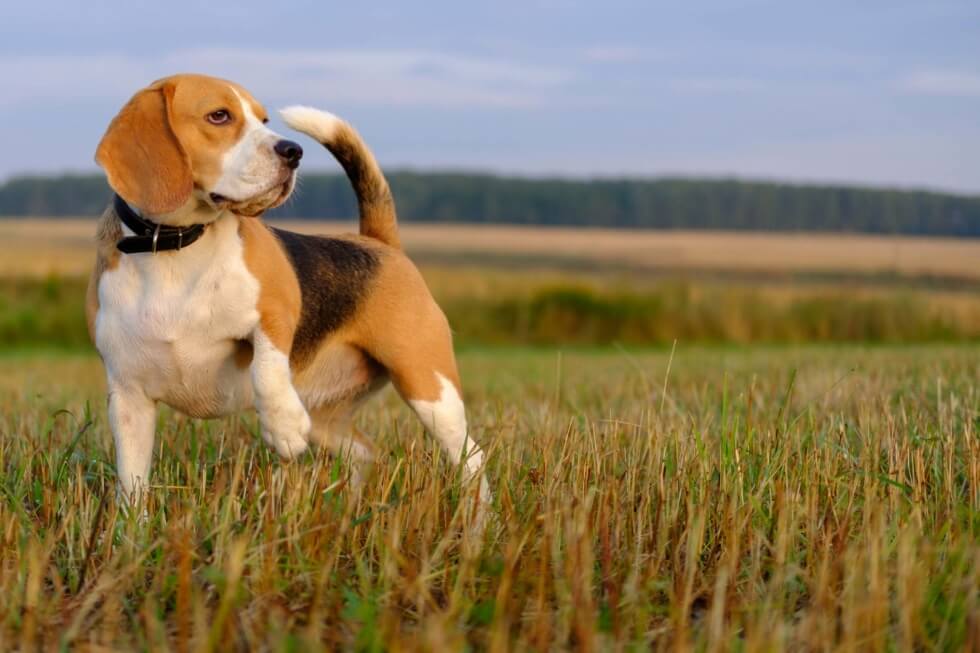
Height: 13-15 inches
Weight: 20-25 lbs
Speciality: Rabbit, hares and small prey
Life expectancy: 12-15 years
If you were playing Top Trumps with hunting dog breeds, the Beagle is the card you’d want. With skills which have been honed over centuries of breeding, the Beagle is made for hunting. Its famous tricolor coat is attractive but make no mistake, below his adorable exterior lies a hardened hunter.
Beagles are a scent hound and are one of the best. In fact, their sense of smell is only bettered by a bloodhound. With full nostrils the beagle doesn’t need much prompting and can often pick up a trail without any encouragement at all. But you’ll know if the beagle has found his prey as his call is loud and distinctive, and known as a bay.
A fiercely intelligent breed, the beagle forms a close bond with its owner. They make the ideal companion when hunting rabbits, hare and small prey and their savvy when in the field is a large part of their success.
Pros:
- Very keen sense of smell
- Proven track record in hunting small animals
- Intelligent and alert
- Energetic and determined
- Great all-round hunter
Cons:
- Very loud
- Can be stubborn to train
3. Labrador Retriever
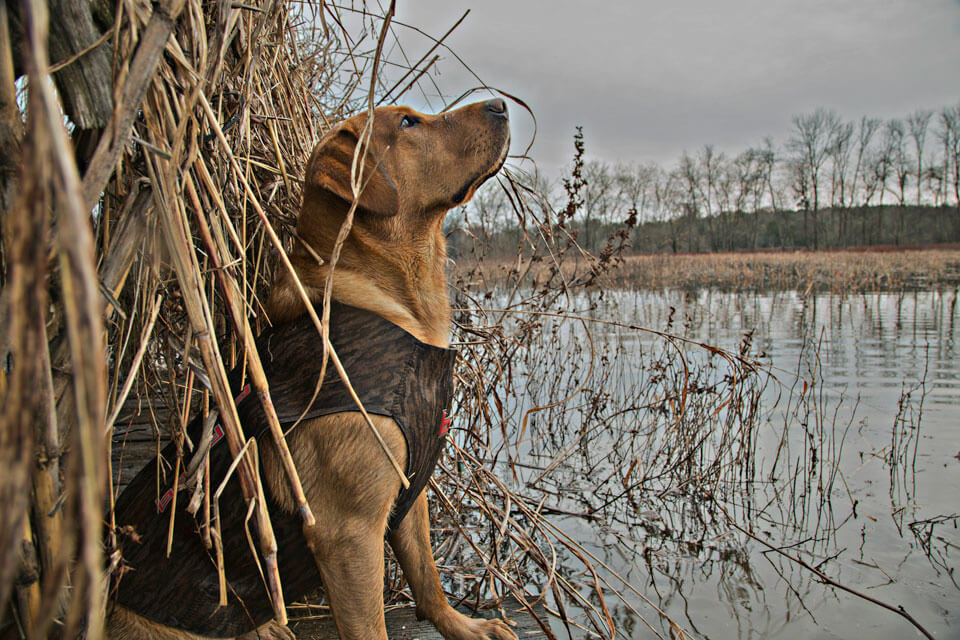
Height: 21-24 inches
Weight: 25-35kg
Speciality: Water retrieving
Life expectancy: 10-12 years
They may look very cute wrapped in toilet roll on TV ads but ask a duck how friendly a Labrador Retriever is and you might get a very different answer. We’re more familiar with seeing the cute and cuddly side of a Lab, but the truth is that they’re an incredible hunter who won’t think twice about joining you to track prey.
Hailing from Canada, the Lab Retriever was created as a working dog, but primarily for water rather than land. The sworn enemy of ducks, water fowl, fish and other small creatures that hang out near water, this breed was the original fisherman’s friend. Helping to retrieve fish that fell off hooks in freezing cold water and hauling in full nets, Labrador Retrievers aren’t bothered by wet and cold conditions.
Quite the opposite in fact, as physically the Lab Retriever is perfectly suited to hunting in cold water. The short-haired coat isn’t just water-resistant, it’s also ice-resistant so they’re happy at low temperatures. Their tail is thick and long, and when in the water acts as a rudder, sort of like an oversized otter.
Fun fact: Labradors weren’t originally from Labrador, but Newfoundland. They were originally known as Lesser Newfoundland but that’s just not a cool name, right? Thankfully, some posh folk in England started to call them Labradors and the name stuck. No more of this “lesser” business, thanks very much!
Pros:
- Good at swimming
- Can withstand cold temperatures
- Water-resistant coat
- Enthusiastic and loyal
- Little grooming required
- Easy to train
Cons:
- Needs to be kept stimulated
- You’ll have to drag them away from the family!
4. Chesapeake Bay Retriever
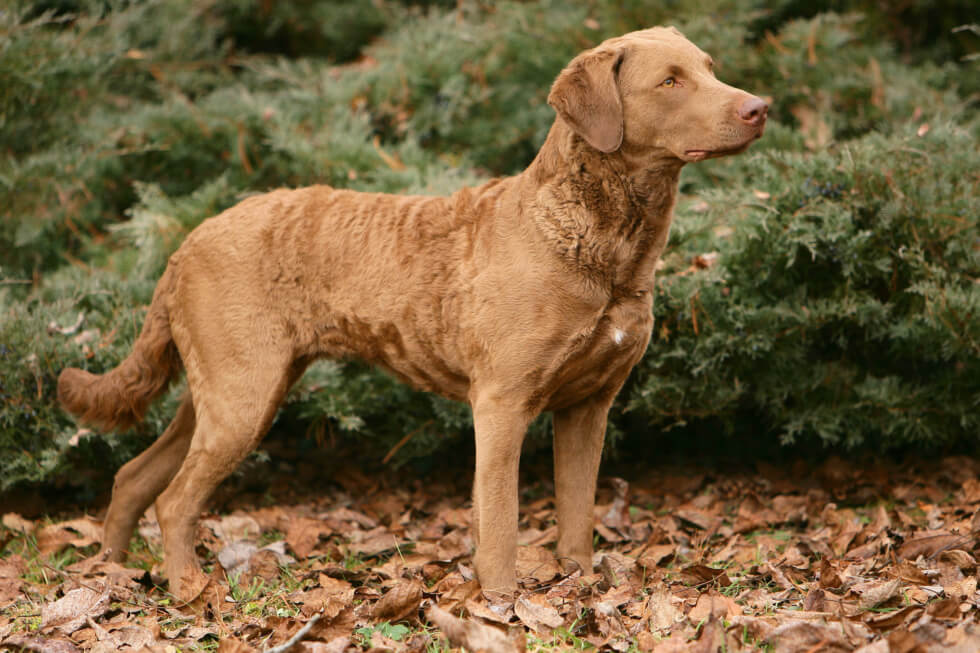
Height: 21-26 inches
Weight: 55-80 lbs
Speciality: Duck hunting
Life expectancy: 12-14 years
Don’t tell his hunting dog pals, but the Chesapeake Bay Retriever is often known by the not-so-macho name of Chessie. Created from several breeds including Newfoundlands, hounds and water spaniels, this breed isn’t the best-known of the retrievers but it’s got a combination of physical features that make it perfect for hunting in and around water.
A double coat keeps the dog warm but with the outer layer being made from oily, thick fur it’s extremely water-resistant and quick to dry. You can comfortably allow your Chessie to break through ice, swim in choppy water and they’ll still retrieve birds reliably. And best of all, they’ll enjoy the challenge too; colder conditions don’t seem to bother this breed.
But the Chessie isn’t just a prime waterfowl retriever, he can also play a part in flushing out prey on dry land. As a hard-working dog who is happy to tackle any type of challenging terrain, the Chessie is smart, resilient and will run for days.
Pros:
- Never-ending stamina and energy
- Supreme in all water conditions
- Can easily withstand cold temperatures
- Versatile enough to flush prey on dry land too
- Easily trained
Cons:
- Can have an independent streak
- May not mix well with other dogs
5. Bluetick Coonhound
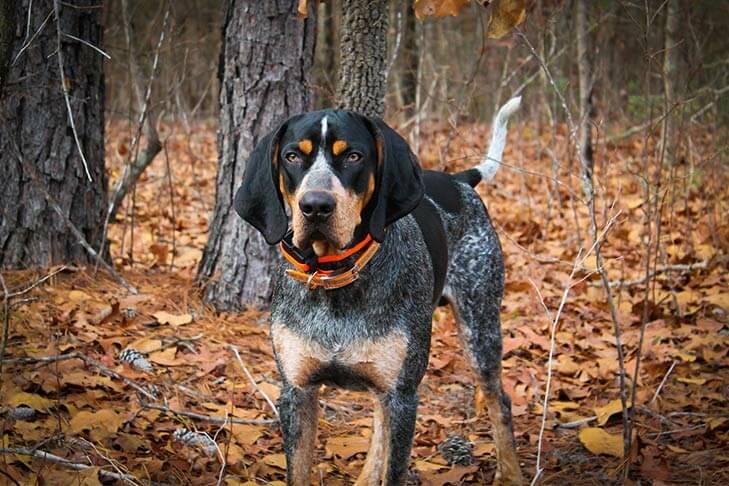
Height: 23-30 inches
Weight: 45-100 pounds
Speciality: Raccoons, night hunting
Life expectancy: 11-12 years
We’re sure you’re not old enough to remember the original Huckleberry Hound, but maybe you caught it on a repeat? (That’s what we’re claiming anyway….) If so, the next entry on our list might look a bit familiar, a Bluetick Coonhound.
Although old Huck wasn’t too big on getting his paws dirty, that’s not the case with this tough hunting dog. Bluetick Coonhounds are known for their courage, and they think nothing of tackling a mountain lion!
Their name is a bit of a giveaway but Bluetick Coonhounds were originally bred to deal with those pesky raccoons. Strong and hardy, the coonhound will enthusiastically cover any type of terrain and will track for long periods to reach their prey. As a scent hound their sense of smell is acute and they can follow even the faintest trail while out hunting.
The prey drive of a coonhound is immense and they need robust training to make sure that they’ve obedient and kept under control. Once properly trained, this medium to large hunting dog is incredibly useful in tracking prey, particularly because their sensitive vision allows them to work well at night.
Pros:
- Tough and hardy
- Very intense prey drive
- Bags of stamina
- Willing to plunge into rugged terrain
- Brave and courageous
Cons:
- Training may require persistence
- May be pushy and dominant
6. American Foxhound
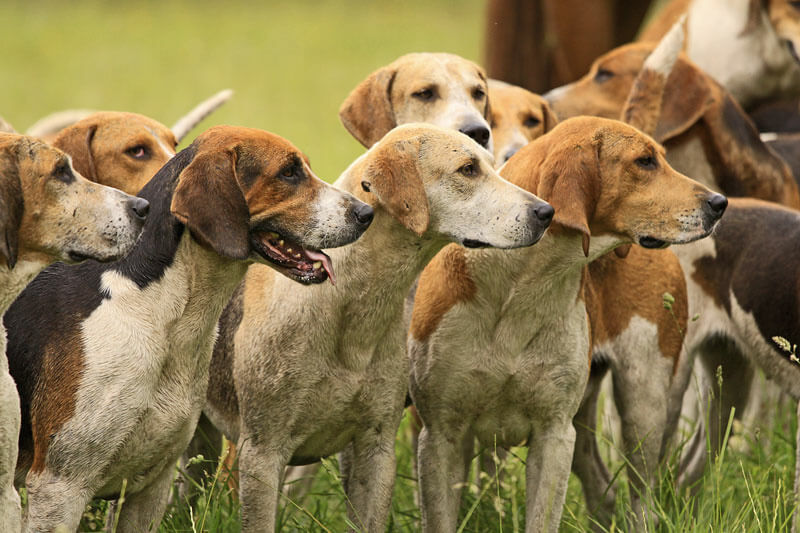
Height: 20-25 inches
Weight: 45-75lbs
Speciality: Medium to large prey
Life expectancy: 10-12 years
If there were such a thing as the all-American dog, the American Foxhound would be it. Created from a combination of different hounds by Founding Father George Washington, the breed was quickly established as a hunter’s companion.
Full of energy, and a willingness to keep going even on difficult terrain, the American Foxhound is an unusual scent hound. Their excellent sense of smell makes them outstanding trackers, but more than anything else, they love to run. This means that although they’re happy tracking, it’s the chase that really makes this canine content!
American Foxhounds are best at chasing larger prey, either foxes – as you could have guessed from the name – or deer. They work well in a pack and they are absolutely relentless. They can be rather vocal but if you’re out on the hunt, this isn’t always a bad thing.
Pros:
- Lots of energy and stamina
- Excellent nose
- Loves running
- Tenacious and determined
- Works well in a pack
Cons:
- Very vocal
- Can be stubborn
7. Weimaraner
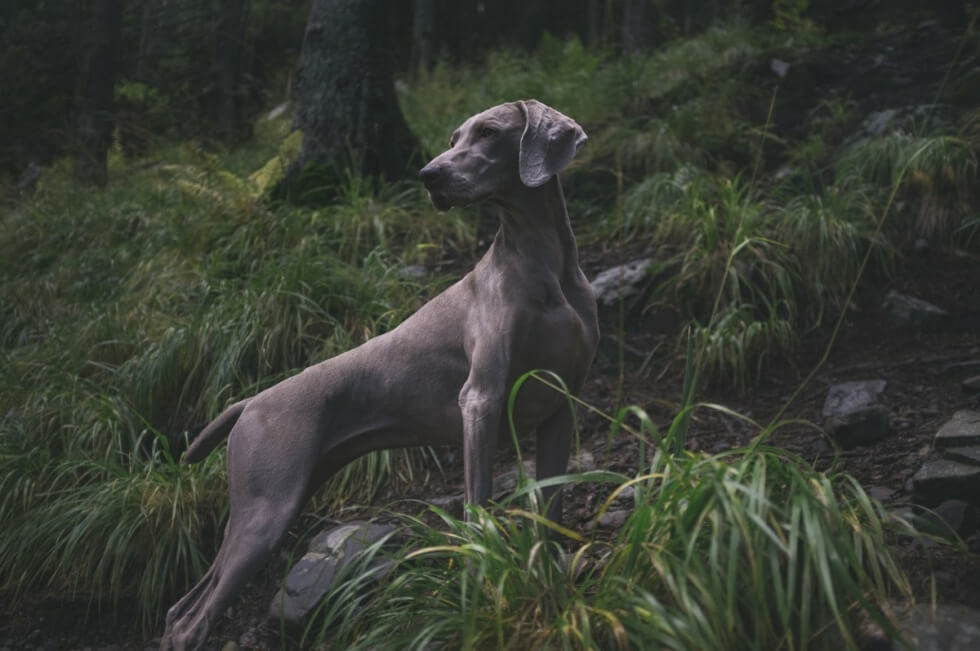
Height: 23-27 inches
Weight: 55-80 lbs
Speciality: All-purpose gun dog
Life expectancy: 11-14 years
Although frequently seen as a family pet, the Weimaraner was originally a hunting dog and with proper training can be a fantastic all-round hunter. As a gun dog, the Weimaraner is good at pretty much everything. They’re a bit like the class swot: strong, powerful and fast, they can track, flush, point and retrieve.
When they were first introduced, the Weimaraner was used to hunt seriously big game including mountain lions, wolves and bears – so your local foxes, rabbits and birds won’t cause them any problems. It’s the latter which Weimaraner are primarily used for today; they are skilled at flushing out birds and retrieving them for the hunter.
Although this breed are fast and skilled at scenting, they’re not especially keen on hunting prey for hours. They have a strong prey drive but don’t want to hunt them down for a long time. For this reason Weimaraner are best for pointing, flushing and retrieving rather than tracking for miles.
Pros:
- Excellent all-round gun dog
- Brave enough to corner any animal
- Skilled at flushing birds
- Fast and intelligent
- Sleek coat that’s low maintenance while outdoors
Cons:
- Doesn’t enjoy hunting over long distances
- Requires confident handling as very strong-willed
8. Bloodhound

Height: 25-32 inches
Weight: 90-130 lbs
Speciality: Tracking
Life expectancy: 7-10 years
Out of all the scent hounds, the bloodhound is the granddaddy. With almost 300 million scent receptors, they can pick up the scent from just a tiny drop of blood buried in thick undergrowth. Just to put that into perspective, humans have around six million scent receptors.
But it’s not just the number of scent receptors that make a bloodhound so successful, it’s also the size of its olfactory area. Much bigger than average, the sensors create an “odor image” in the dog’s brain which helps them to track. And track they will – bloodhounds have been known to follow a trail for more than 130 miles, even when it’s a relatively cold trail.
Their whole physicality contributes to their astonishing scent ability. The wrinkles in its skin trap the scent and the long ears sweep more scent particles towards the nose. The bloodhound also has a long neck – albeit not quite giraffe dimensions – this allows him to hunt with his nose close to the ground for mile after mile.
When it comes to tracking prey, there’s literally no other canine which comes close to a bloodhound. However, they’re not quite so skilled at other areas of hunting. A brave dog, they’ll defend their owner against even the largest attacker, but don’t expect them to show any aggression towards the prey. They’re just interested in finding it, nothing more.
Pros:
- The best scent hound around
- Can track for many miles
- Able to pick up “cold” trails
- Bonds well with its owner
Cons:
- Shorter life expectancy than other breeds
- Lacks the more aggressive hunting characteristics
9. Standard Poodle
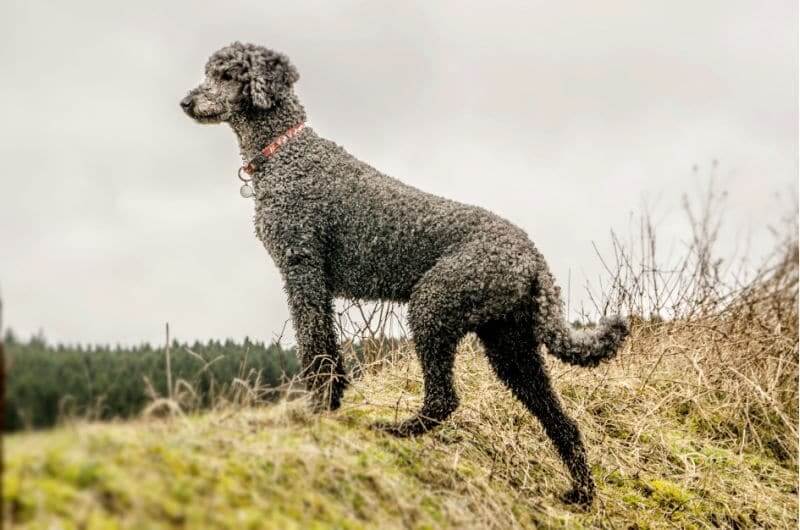
Height: 22-26 inches
Weight: 40-60 lbs
Speciality: All-round retrieving
Life expectancy: 12-15 years
When you learn that the poodle’s name came from their native German “pudeling” – which means splashing in water – the breed’s fondness for retrieving waterfowl becomes clear. Standard poodles all began as water retrievers, even though they might not look like the traditional hunting dog.
The fluffy coat of a poodle gets a lot of attention, but in the hunting world you won’t see the intricate Crufts-style cuts. Instead, their coat is trimmed to around one inch long all over which allows it to curl into the body and provide protection and warmth.
As a single layer coat with good water-resistance, the poodle is well-equipped for wet work. The curly coat helps to keep out the cold and also stops brambles and thorns from piercing the skin.
Poodles are very intelligent, and like other retriever breeds can be used in a variety of ways. Water retrieving may have been their original purpose but they are also good at flushing out prey on land, and carrying out general all-round retriever hunting jobs too.
Pros:
- Versatile to do all types of retrieving
- Quick-drying coat and strong swimming skills
- Enjoys pleasing their owners
- Intelligent and loves to learn new things
- Athletic build
Cons:
- Has a reputation for being fancy
- Needs close companionship when not hunting
10. Dogo Argentino
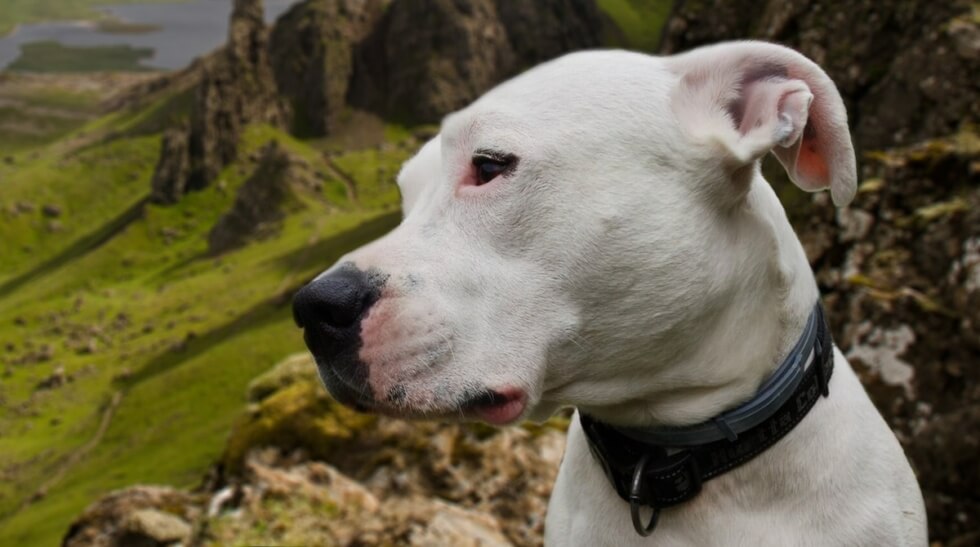
Height: 24-27 inches
Weight: 80-100 lbs
Speciality: Big game hunting
Life expectancy: 10-12 years
Also known as an Argentinian Mastiff, the Dogs Argentino is an absolute powerhouse. They were originally bred from fighting dogs but the most aggressive traits have been eliminated so they could work with other dogs as hunters. The end result is a canine which is brutally strong, muscular and with some seriously big balls. Metaphorically, not literally. Nothing scares the Dogo and they are fearless in the face of danger.
Their large stature and courage means that they’re used to great effect in big game hunting. There’s no flushing quail out of bushes for these big beasties. With their large, flat head, powerful build and strong prey drive, they make a fearsome hunter of even the biggest prey.
For such a large and tough dog, the Dogo Argentino is surprisingly sensitive and craves physical contact. Ignore them and they’ll act like an overgrown toddler clamoring for attention. They can get very distracted by different scents and can be boisterous, so strong and consistent training is vital for them to fulfill their hunting potential.
Pros:
- Muscular and powerful
- Coat is low-maintenance
- Brave and courageous
- Strong prey drive
Cons:
- They are banned in some countries due to being used as a fighting breed
- Experienced ownership essential
11. American Water Spaniel
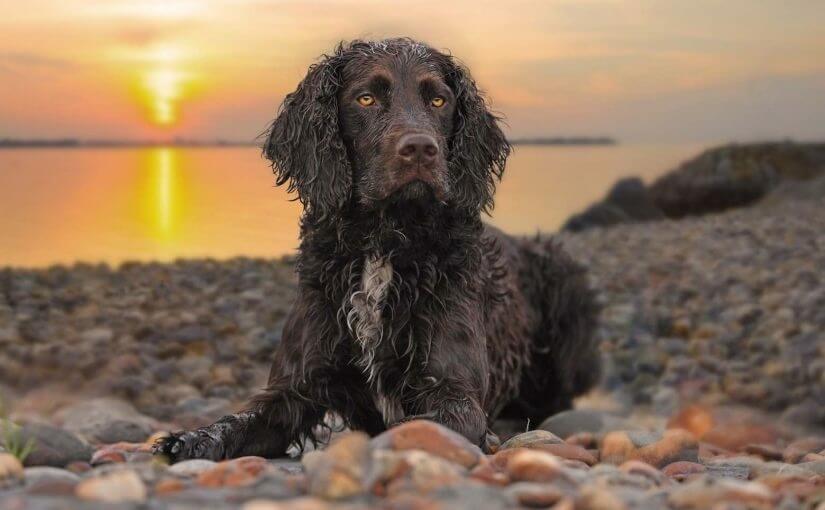
Height: 15-18 inches
Weight: 25-45 lbs
Speciality: Waterfowl retriever
Life expectancy: 13-15 years
Spaniels usually do a pretty good job in the field of hunting but the American Water Spaniel is top of the pile. Much rarer than his cousins, the American Water Spaniel – or AWS as they are often dubbed – is a specialized hunter and loves nothing more than to flush out birds.
They are especially good at retrieving waterfowl. With a name like “water spaniel”, that was probably a bit of a giveaway though! The AWS is a rare breed but stands out for its hunting skills. It was bred specifically to scent out waterfowl and is tenacious when tracking wounded birds. It shrugs off cold and wet conditions, making it particularly suited to work in the water.
But in addition to its supreme hunting ability, it also has all the desirable qualities of a spaniel. Any spaniel-owner will know the fun, loving and loyal nature of spaniels make them a joy to be around. They’ll guard your home while also being a soppy family dog giving you the best of both worlds!
Pros:
- Comfortable in cold and wet conditions
- Works methodically and slowly
- Enjoys tracking waterfowl
- Tenacious scent hound
Cons:
- Harder to train than other breeds
- Difficult to source due to rarity
12. Jack Russell Terrier
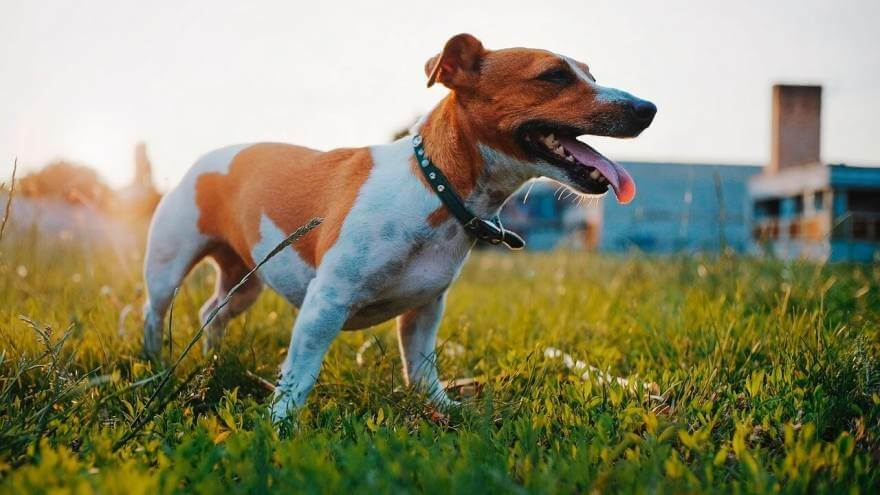
Height: 13-14 inches
Weight: 13-17 lbs
Speciality: Hunting rodents
Life expectancy: 13-15 years
The smallest dog on our list, the Jack Russell Terrier comes with a huge reputation. Known for their fondness for attacking the mailman, this diminutive breed is more than capable when on the hunt. Initially bred to hunt foxes, the Jack Russell never lets size prevent him from tackling prey. They are high energy and high on confidence, and if one decides to go after a rodent or other critter, you’ll struggle to hold them back!
The prey drive is very strong in Jack Russells which makes them dangerous to be around other small family pets. It’s impossible to train the prey instinct from them, and they love nothing more than being given the job of chasing an unwanted rodent away.
As a working terrier, Jack Russells bay when they’ve found their prey. This makes them perfect for flushing out foxes, rabbits and rodents for the hunter to pick off. Believe it or not, the Jack Russell has been used for big game hunting too. The idea of the little dog facing off against a giant lion may sound ridiculous but many hunters swear that they are the only breed that’s brave enough to face the large game, while being agile enough to escape if the need arises!
Pros:
- Strong prey drive
- Intelligent and willing to learn
- Lots of stamina and energy
- Can be used with small and large prey
Cons:
- Can become over-exuberant when in the field
- Smaller size makes them unsuitable for very long-distance hunts
13. Vizsla

Height: 21-24 inches
Weight: 45-66 lbs
Speciality: Gun dogs
Life expectancy: 12-15 years
The exotic name for this breed harks back to their Hungarian ancestry where Vizsla were bred as hunting dogs and ran alongside the horses. However, unusually for a hunting breed they were also prized as companions. These dual traits are still evident in modern Vizsla who delight in pointing and retrieving, but love pleasing their owners even more.
As a gun dog, the Vizsla points and retrieves but also has a great sense of smell. They have been used to net falcons, as well as flushing and retrieving birds such as grouse, snipe, partridge and pheasant. Their build is lean and athletic, but they’re not the steroid-pumped bodybuilders of the canine world. Compared to other breeds, they’re not as powerful but their long legs allows them to cover ground quickly in a graceful gallop.
These physical attributes mean the Vizsla prefers to work at close to medium range, and doesn’t really like to be out of their owner’s eyeshot for long. Their smooth single coat doesn’t have any underlying woolliness which makes it easy to wipe clean. It also means that it doesn’t get too stinky. The only downside is that the single coat doesn’t provide a lot of insulation so the Vizsla doesn’t cope well in colder temperatures.
Pros:
- Graceful and athletic
- Low-maintenance coat
- Excellent at pointing, retrieving and flushing
- Intelligent and loves to please
Cons:
- Cannot withstand the cold
- Can be anxious if they get too far from their owner
14. Wirehaired Pointing Griffon

Height: 22-24 inches
Weight: 50-70 lbs
Speciality: Water and thick undergrowth
Life expectancy: 12-15 years
Despite sounding more like a magical creature Hagrid may have kept at Hogwarts, Wirehaired Pointing Griffons are traditional hunting dogs. Although – as their name implies – they are a pointer, they have versatile skills which make them invaluable out in the field.
Their thick and wiry coat gives them protection while hunting, making them impervious to cold weather and brambles. They are as comfortable burrowing through thick undergrowth as they are plunging into swampy water to chase down or retrieve prey.
Colloquially known as Griffs, this breed does more than your average pointer. Able to point and retrieve on dry and wet land, they also have an outstanding sense of smell, superior stamina and a surprising amount of power.
Pros:
- Hardwearing coat which barely sheds
- Is agile and athletic
- Excels in a range of different conditions and terrains
- Copes well with cold and difficult conditions
- Good for working close at hand
Cons:
- Needs strong obedience training as can be easily distracted
- Can bark a lot
15. Rhodesian Ridgeback
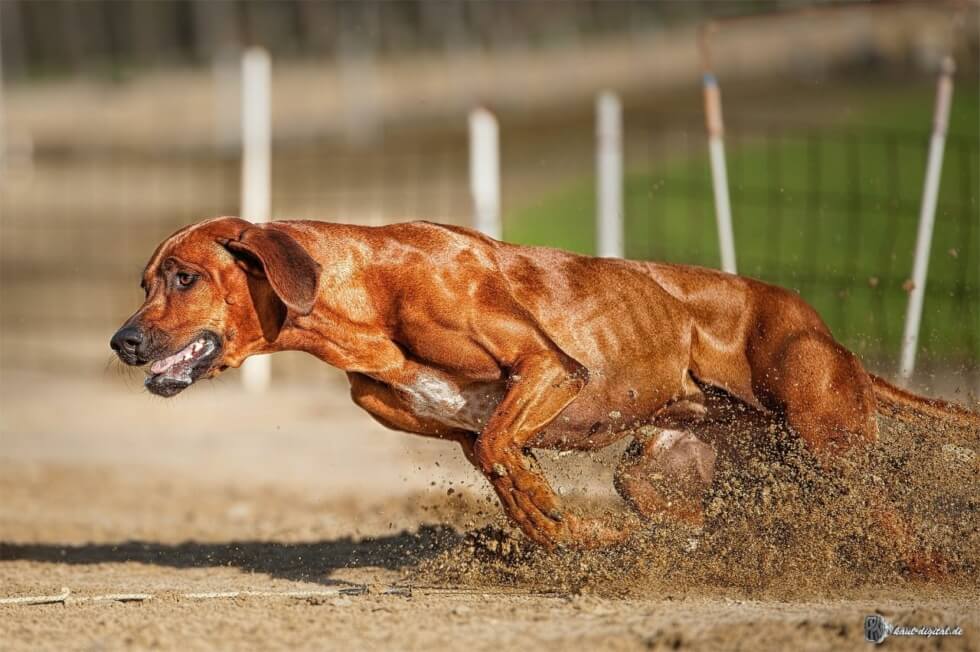
Height: 24-27 inches
Weight: 70-110 lbs
Speciality: Large prey
Life expectancy: 10-12 years
Could you think of a better hunting companion than a dog who’s not afraid to take down a lion? That’s what you’ll get with the Rhodesian Ridgeback as this African breed was originally created to help with the threat of lions.
Although they were often used to guard homes from lions, hunters quickly realized that the breed’s bravery and ferocity would be ideal in subduing big game on the savanna plains.
Large, athletic and powerful, Rhodesian Ridgebacks were bred from African wild dogs and proved to be adept in hunting lions, wild pigs and baboons. Their instincts for tracking haven’t lessened through breeding and they have an extremely strong prey drive which is one of the reasons they’re difficult to keep as pets (although they will keep next door’s cat away!)
As a scent hound, they are exemplary at tracking and won’t give up until they find their prey. Their athleticism means they can follow a scent for many miles and don’t like to be pulled off the trail. Although the Ridgeback is courageous in squaring up to large prey, they don’t usually kill. Instead, they trap and corner the animal until their master arrives.
Pros:
- Intelligent and loyal
- Strong hunting instinct
- Tenacious when tracking
- Excellent scent hounds
Cons:
- No undercoat so doesn’t tolerate the cold well
- Strong-willed; experienced owner recommended
Your Canine Hunting Companion
Let’s face it, there are many breeds of dog which would kick butt as a hunter’s companion. Although we’ve listed 15 of the best here, there are many others we could have included. Right now, there will be some owners roaring about the glaring omission of their breed – owners of English setters, Springer Spaniels and Golden Retrievers, we’re looking at you…
The hunting breeds we’ve featured here cover all sorts of hunting. So whether you’re planning on shooting duck or hunting down big game, one of the above breeds could be perfect as your canine sidekick.
FAQs
Can a hunting dog also be a family pet?
There are many breeds of hunting dog which also make great family pets. Some examples include Beagles, Labrador Retrievers and the American Water Spaniel.
However, if you want them to be adept at hunting as well as good company around the home, you’ll need to make sure you train both aspects. To work as a hunter, dogs need lots of exercise in difficult conditions, and desensitization to the noise of guns. As a family pet, the pooch should be well-socialized and not too territorial or protective.
What is the most intelligent hunting dog?
All hunting dogs are intelligent because to be successful, it’s necessary to be able to understand and follow lots of different instructions. Out in the field, conditions can change rapidly and hunting breeds need to be able to adapt swiftly.
However, if you could only pick one breed to sit the equivalent of a doggy Mensa test it would probably be the bloodhound. Labrador retrievers and pointer owners might feel a bit aggrieved here, as both these breeds are clever canines too.
How do I choose the best hunting dog?
There’s no single right answer about the best hunting dog, but it’s vital to match the breed to your needs. Some dogs work well ranging at distance while others prefer sticking close to their owner while out in the field. Do you want a dog to retrieve, flush or dive in the water? Not all hunting dogs are made the same so be certain about their purpose and look for a breed that ticks the boxes.
You’ll probably come up with a few potential breeds; to help narrow it down consider how the dog will be living at home. Do you want an affectionate family dog, or are you looking for a guard dog to live outside in a kennel? Some hunting dogs aren’t ideal for family pets, while others would be miserable living outside and away from their owner.
Pawsome Pals!
If you’ve been on the trail of a new hunting dog, hopefully we’ve given you paws for though. With everything you need to know in our comprehensive guide, all that’s left for you to do is go out and find your canine companion.

